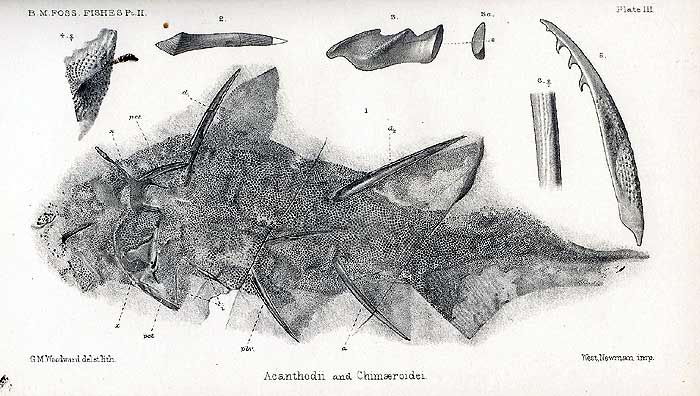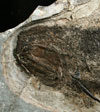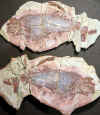ACANTHODII
Characterised by the presence of large ornamented bony spines in front of all the fins except the caudal and tiny scales that have a bulbous base. First described by Agassiz in 1844 they are often called the ‘spiny sharks’ although there is much debate as to whether they are closer to the bony fish than elasmobranches. They lasted almost 200 Myn years from the Early Silurian to the Early Permian. The three major acanthodian clades are the Climatiiformes, Ischnacanthiformes and Acanthodiformes. The climatiiforms are the oldest, having elaborate bony shoulder girdle armour and many spines. The ischnacanthiformes were predators with teeth and the acanthodiformes filter feeders that were the longest surviving group. The acanthodians are mostly marine but given their presence in the Old Red Sandstone these had to be living freshwater.

Acanthodian from 'Catalogue of Fossil Fishes' AS Woodward 1891
Acanthodii in my collection
Climatius reticulatus, Lower Devonian, Tillywhandland, Scotland
This early climatiiform had numerous, heavily ornamented, broad based fin spines. The two large dorsal, single anal, paired pelvic, four paired intermediate and large paired pectoral fin spines would have made it a very nasty mouthful. It has an advanced shoulder girdle made up of a three paired pinnal plates and a single anterior and posterior lorical bony plate. Articulated examples are incredibly rare.
Vernicomacanthus uncinatus, Lower Devonian, Tillywhandland, Scotland
Brachyacanthus scutiger , Lower Devonian, , Scotland
Euthacanthus macnicolli, Lower Devonian, Tillywhandland, Scotland
Another classic early climatiiform, with a much less advanced shoulder girdle than Climatius, made up of only single paired pinnal plates. It also had five intermediate spines and is toothless.
Parexus recurvus, Lower Devonian, Tillywhandland, Scotland
Notable for its very large anterior dorsal fin spine. The shoulder girdle of Parexus is intermediate between those of Climatius and Euthacanthus, being formed of a single lorical and paired pinnal plates.
Mesacanthus mitchelli (Egerton), Lower Devonian, Tillywhandland, Scotland
Mesacanthus means 'middle spine' because as well as being the basal acanthodiform, it is the only one to have intermediate spines between the pectoral and pelvics. As with all acanthodians it was a filter feeder, with well developed rakers.
Ischnacanthus gracilis, Lower Devonian, Tillywhandland, Scotland
As can be seen below, this basal Ischnacanthiform has robust upper and lower jaw bones, the biting surface of which contains gnathal bones looking rather like fused rows of teeth. The name means 'thin spine' and as can be seen again below, they lacked the boney plates seen in the shoulder girdle of the climatiiformes.

 Skull detail of a large individual. Very fine dentary structures
Skull detail of a large individual. Very fine dentary structures
Unknown Welsh Borders Acanthodian (Part of the wonder-block - see osteostracans)
St Maughans Formation, LORS, Brecon, Wales
Cheiracanthus sp. Mid Devonian
First described by Agassiz in Poissons fossiles, this is a common Middle Devonian Acanthodiform.
 Cheiracanthus
latus,
Tynet burn, Scotland
Cheiracanthus
latus,
Tynet burn, Scotland
 Cheiracanthus
latus,
Tynet burn, Scotland
Cheiracanthus
latus,
Tynet burn, Scotland
Diplacanthus sp. Mid Devonian Tynet burn, Scotland
Again, this common Middle Devonian Climatiiform was first described by Agassiz. Meaning 'paired-spines', it was a deep bodied fish that retained its ancestors intermediate spines (2 pairs) but lacked the heavily armored shoulder girdle. It lacks ancillary gill covers, is toothless and had particularly short jaws.
Acanthodes sulcatus. Carboniferous, Peel Glen, Scotland
One of the most specialised of all acanthodians with the anal and dorsal fins in the same posterior position and loss of the pelvic fins
Other Acanthodes sp
![]() Acanthodes sp, Mazon creek USA
Acanthodes sp, Mazon creek USA
 Acanthodes bronni, Lebach, Germany
Acanthodes bronni, Lebach, Germany
 Acanthodes lundi, Bear Gulch, USA
Acanthodes lundi, Bear Gulch, USA
OTHER ACANTHODIANS
![]() Homalacanthus concinnus U.Devonian
Miguasha Canada
Homalacanthus concinnus U.Devonian
Miguasha Canada
 Triazeugacanthus U.Devonian
Miguasha Canada
Triazeugacanthus U.Devonian
Miguasha Canada
![]() Gyracanthus sp.
Carboniferous(Namurian)
Cowdenbeath,
Scotland
Gyracanthus sp.
Carboniferous(Namurian)
Cowdenbeath,
Scotland














